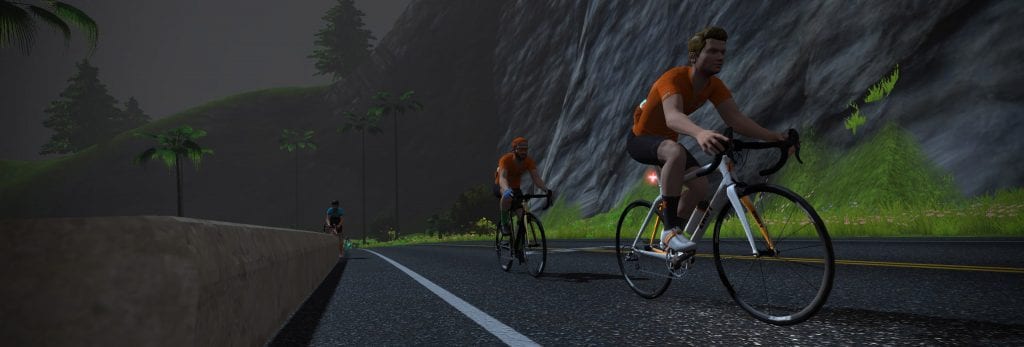Cyclists know that staying in the draft saves watts. It’s been tested outdoors, and it’s been tested on Zwift. This knowledge is important to understand and put into practice because bike racing is all about conserving energy so you have it when you need it. Drafting is the #1 way a cyclist conserves energy while remaining in contention for the win.
But how many watts do you save in the draft – and does that change based on whether you’re on a climb, a descent, or a flat road? We decided to to run a few tests in the Zwift Insider Lab to get some hard numbers.
About the Test
For our test we had two riders: Rider 1 pulling on the front, and Rider 2 drafting behind Rider 1. Both riders were 75kg in weight, 183cm tall, and riding Zwift Aero bike frames with Zwift 50mm wheelsets.
We took these riders over the Watopia Hilly KOM segments (forward and reverse) with Rider 1 pulling at 330 watts for one test, then 270 watts for the other. We also took them on Ocean Boulevard for a flat test at the same wattage. Rider 1’s job was to hold the wheel using as few watts as possible.
These tests were made with other Zwifters on the road, and required constant adjustment of Rider 2’s wattage to properly hold the wheel. This means the test results aren’t perfect. But they’re still certainly useful!

Drafting Up Climbs
On the Hilly KOM Forward climb:
- drafting a rider holding 330 watts requires 320 watts – a 3.1% savings
- drafting a rider holding 270 watts requires 264 watts – a 2.3% savings
On the Hilly KOM Reverse climb:
- drafting a rider holding 330 watts requires 292 watts – an 11.6% savings
- drafting a rider holding 270 watts requires 244 watts – a 9.7% savings
The steeper the climb, the slower the speed. The slower the speed, the less effect drafting has since drafting is all about reducing wind resistance and wind resistance isn’t an issue at slow speeds. So we see on these climbs there is certainly some savings in the draft, but it’s not nearly as significant as we’ll see on flat roads or descents.
The savings is greater on the reverse climb because that climb isn’t as steep as the forward climb. Therefore, speeds are faster on the reverse KOM, and drafting has a greater effect.
Similarly, the savings are greater when drafting the 330-watt rider compared to the 270-watt rider, because speeds are faster behind the 330-watt rider, so drafting has a greater effect.
Drafting On Descents
On the Hilly KOM Forward descent:
- drafting a rider holding 330 watts requires 207 watts – a 37.3% savings
- drafting a rider holding 270 watts requires 145 watts – a 46.3% savings
On the Hilly KOM Reverse descent:
- drafting a rider holding 330 watts requires 227 watts – a 31.3% savings
- drafting a rider holding 270 watts requires 222 watts – a 17.8% savings
Descents are much faster than climbs, and the main thing slowing riders down on a descent is air resistance. Drafting greatly reduces air resistance, so riders in a draft on a descent can sit in with very low watts even when the rider ahead is hammering.
The steeper the descent, the greater the savings from the draft. So we see the steeper forward descent gives us a greater savings than the reverse descent.
And just like on the climbs, the savings will be greater when drafting the 330-watt rider compared to the 270-watt rider, because speeds are faster behind the 330-watt rider, so drafting has a greater effect. We don’t see that exactly in the results above, because holding the wheel over changing gradients was difficult in our tests!
Drafting On Flat Roads
On Ocean Boulevard:
- drafting a rider holding 330 watts requires 241 watts – a 27% savings
- drafting a rider holding 270 watts requires 208 watts – a 23% savings
We would expect the power savings on flats to fall somewhere in between the savings we saw on the climbs and the descents, and that is indeed the case (apart from the hilly KOM reverse data at 270 watts which is probably just a testing error – like we said, these tests weren’t perfect!)
Here we see once again that riders achieve greater savings when drafting a more powerful rider because speeds are higher, so drafting has a greater effect.
Takeaways
There are several useful takeaways from these test results:
- Descents provide a wonderful opportunity to recover, if you play it smart. Stay out of the wind, surf the wheels, and apply just the power needed to stay in the pack. Of course, there’s always the supertuck as well, but that is best used on longer, steeper descents.
- Drafting is a significant factor on shallow climbs like the hilly KOM reverse. So play it smart and stay on a wheel unless you’re attacking.
- The faster you’re traveling, the bigger that “wattage window” is where you’ll stay with the rider you’re following. That’s why our descent test results were a bit messy. (The “wattage window” is the minimum and maximum wattage you can hold and without being dropped or dropping the rider you’re trying to follow.) This means you can potentially waste a lot of watts by hammering too hard–so play with it, ease up, and see how little you can work to hold the wheel on descents and even flatter roads. With practice, you’ll get a feel for it.
- If you think this savings is impressive, consider this: the draft effect is even stronger in larger groups on Zwift! This is difficult to test (requiring many computers, Zwift accounts, etc) but we know there is a stronger draft behind 4 riders than behind 1.
Your Thoughts
Do these results make sense to you? Got questions, or additional takeaways from the data? Share below!